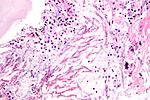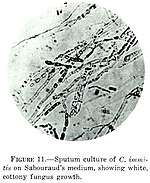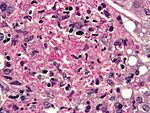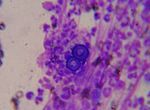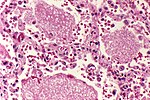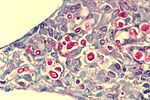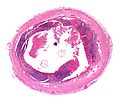Difference between revisions of "Microorganisms"
(→Leishmaniasis: fix) |
|||
| (11 intermediate revisions by 3 users not shown) | |||
| Line 146: | Line 146: | ||
<gallery> | <gallery> | ||
Image:Schistosomiasis_haematobia.jpg | Schistosomiasis haematobia. (WC) | Image:Schistosomiasis_haematobia.jpg | Schistosomiasis haematobia. (WC) | ||
Image:Schistosoma_-_intermed_mag.jpg | Schistosoma eggs - intermed. mag. (WC) | Image:Schistosoma japonicum (1) histopathology.JPG | Schistosoma japonicum. (WC/KGH) | ||
Image:Schistosoma_-_very_high_mag.jpg | Schistosoma eggs - very high mag. (WC) | Image:Schistosoma japonicum (2) histopathology.JPG | Schistosoma japonicum. (WC/KGH) | ||
Image:Schistosoma japonicum (3) histopathology.JPG | Schistosoma japonicum. (WC/KGH) | |||
Image:Schistosoma_-_intermed_mag.jpg | Schistosoma eggs - intermed. mag. (WC/Nephron) | |||
Image:Schistosoma_-_very_high_mag.jpg | Schistosoma eggs - very high mag. (WC/Nephron) | |||
</gallery> | </gallery> | ||
www: | www: | ||
| Line 157: | Line 160: | ||
*Common CNS infection. | *Common CNS infection. | ||
**''Toxoplasma gondii'' - pathogenic; causes ''toxoplasmosis''. | **''Toxoplasma gondii'' - pathogenic; causes ''toxoplasmosis''. | ||
* | *Previously classified as a ''protozoa''. | ||
*A [[TORCH infection]]. | *A [[TORCH infection]]. | ||
===Microscopic=== | ===Microscopic=== | ||
General: | General: | ||
* | *Tachyzoites (Invasive form): | ||
**Crescent-shaped organisms that are 2-3μm wide by 4-8μm long. | |||
*Bradyzoites: | |||
**Are founded within the tissue cysts and are shorter than tachyzoites. | |||
*Oocysst: | |||
**Ovoid shape that measures 10μm to 12μm and contains four sporozoites. | |||
*Histopathological features depend on location in body. | |||
====Lymph node==== | ====Lymph node==== | ||
| Line 351: | Line 361: | ||
Image:Leishmania_donovani_01.png | Leishmania - smear. (WC) | Image:Leishmania_donovani_01.png | Leishmania - smear. (WC) | ||
Image:Leishmania_2009-04-14_smear.JPG | Leishmania - bone marrow. (WC) | Image:Leishmania_2009-04-14_smear.JPG | Leishmania - bone marrow. (WC) | ||
Image:Cutaneous_Leishmaniasis_x100 | Leishmania - cutaneous. (WC) | |||
</gallery> | </gallery> | ||
www: | www: | ||
| Line 365: | Line 376: | ||
{{Main|Bacteria}} | {{Main|Bacteria}} | ||
This is a small topic when considered from the perspective of an anatomical pathologist. Most stuff is sorted-out by microbiology. | This is a small topic when considered from the perspective of an anatomical pathologist. Most stuff is sorted-out by microbiology. | ||
=Protozoa= | |||
A historical category of organisms. Lifeforms previously categorized as ''protozoa'' are in several different ''kingdoms''. | |||
{{Main|Amebiasis}} | |||
{{Main|Leishmaniasis}} | |||
{{Main|Pneumocystis jirovecii}} | |||
{{Main|Toxoplasma}} | |||
=Microorganisms and cancer= | =Microorganisms and cancer= | ||
| Line 393: | Line 411: | ||
{{reflist|2}} | {{reflist|2}} | ||
=External links= | |||
*[http://www.fujita-hu.ac.jp/~tsutsumi/index.html Pathology of Infectious Diseases (fujita-hu.ac.jp)]. | |||
[[Category:Basics]] | [[Category:Basics]] | ||
[[Category:Microorganisms]] | [[Category:Microorganisms]] | ||
Latest revision as of 15:43, 4 December 2023
Microorganisms show-up every once in a while. It is essential to know 'em.
Microorganisms
Fungi
| Name (disease) | Kingdom | Size | Shape | Stains | Other (microscopic) | Clinical | References | Image |
|---|---|---|---|---|---|---|---|---|
| Aspergillus (aspergillosis) | Fungi | ? | Hyphae that branching with 45 degrees angle |
PAS-D | Fruiting heads when aerobic | ? Immunosuppression | [1] | |
| Zygomycota (zygomycosis); more specific Mucorales (mucormycosis) |
Fungi | ? | Branching hyphae with variable width | ? | Granulomata assoc. | Diabetes, immunodeficient | [1] | |
| Coccidioides, usually C. immitis (coccidioidomycosis) |
Fungi | Large - 20-60 micrometers, endospores 1-5 micrometers |
Spherules | Stains? | Other? | Immunodeficient | [1] | Coccidioidomycosis (med.sc.edu) |
| Histoplasma (histoplasmosis) | Fungi | 2-5 micrometers | Spherical | GMS | Intracellular (unlike candida), granulomata | Source: soil with bird droppings | [1] | |
| Blastomyces (blastomycosis) | Fungi | 5-15 micrometres | Spherical (yeast) | Stains? | Granulomas, broad-based budding yeast | Habitat: Northeast America, Africa | [1][2] | |
| Paracoccidioides (paracoccidioidomycosis) | Fungi | 6-60 micrometres | Spherical (yeast) | Stains? | Multiple budding "steering wheel" appearance | Clinical??? | [1] | |
| Pneumocystis jirovecii (pneumocystis carinii pneumonia; abbrev. PCP) | Fungi (previously thought to be a protozoan) | 7-8 micrometres | "Dented ping-pong ball" | GMS | Usually in clusters of alveolar casts with a honeycomb appearance | HIV/AIDS associated | [3] | |
| Cryptococcus (cryptococcosis) | Fungi | 5-15 micrometres | Yeast | GMS | Prominent (i.e. thick polysaccharide) capsule | HIV/AIDS associated, most common CNS fungus | [1] |
Notes:
- Bold text = key features.
Fungi
- There are lots of 'em. Below are a few of 'em.
Terminology:[4]
- Hyphae = microscopic filamentous growth (of fungi) -- single cell.
- Mycelial = filamentous network of hyphae.
- Septae/septation = hyphae may be subdivided by septae -- if they aren't they are one mass of protoplasm. (?)
- Dimorphism = exist in two forms; e.g. single cell (yeast) and mycelial growth.
- Pseudohyphae = looks like hyphae --but branching pattern is created by separate cells.[5]
Tissue invasive fungi
Typically:[6]
- Mucor.
- Aspergillus.
List
- Histoplasmosis.
- Coccidioidomycosis.
- Pneumocystis pneumonia.
- Cryptococcus.
- Cryptosporidiosis.
- Candidiasis.
- Blastomycosis.
- Mucormycosis.
Worms & stuff
Schistosomiasis
- See Urine cytopathology.
General
- Trematode, i.e. type of worm.
- Due to:
- Schistosoma mansoni.
- Schistosoma haematobium.
- Schistosoma japonicum
- S. haematobium infection associated with squamous cell carcinoma of the urinary bladder.
- Classically presents with hematuria.
Microscopic
Features of ova (S. haematobium):[7]
- Elliptical ~140 micrometres max dimension.
- "Spike" approx. the size of a PMN.
Images
www:
Toxoplasma
General
- Common CNS infection.
- Toxoplasma gondii - pathogenic; causes toxoplasmosis.
- Previously classified as a protozoa.
- A TORCH infection.
Microscopic
General:
- Tachyzoites (Invasive form):
- Crescent-shaped organisms that are 2-3μm wide by 4-8μm long.
- Bradyzoites:
- Are founded within the tissue cysts and are shorter than tachyzoites.
- Oocysst:
- Ovoid shape that measures 10μm to 12μm and contains four sporozoites.
- Histopathological features depend on location in body.
Lymph node
LN features:[8]
- Reactive germinal centers (pale areas - larger than usual).
- Often poorly demarcated - due to loose epithelioid cell clusters at germinal center edge - key feature.
- Epithelioid cells - perifollicular & intrafollicular.
- Loose aggregates of histiocytes (do not form round granulomas):
- Abundant pale cytoplasm.
- Nucleoli.
- Loose aggregates of histiocytes (do not form round granulomas):
- Monocytoid cells (monocyte-like cells) - in cortex & paracortex.
- Large cells in islands/sheets key feature with:
- Abundant pale cytoplasm - important.
- Well-defined cell border - important.
- Singular nucleus.
- Cell clusters usually have interspersed neutrophils.
- Large cells in islands/sheets key feature with:
Images (lymph node):
CNS
CNS features:[9]
- Granular appearing ball ~ 2x the size of resting lymphocyte.
Images (CNS)
www:
- CNS toxoplasmosis (ouhsc.edu).
- CNS toxoplasmosis (ouhsc.edu).
- Toxoplasmosis - several images (upmc.edu).
Heart
Features:
- Intramuscular organisms.
DDx:
- Chagas disease. (???)
Images (heart):
IHC
- IHC for toxoplasma.[10]
Strongyloidiasis
General
- Causes by worm Strongyloides stercoralis.
- High case mortality rate ~ 70%.[11]
- May present after years of latency due to immune suppression.[12]
Location:
- Lung. (???)
Microscopic
Features:
- Long worms.
- ~10-15 micrometers wide.
Images
www:
Echinococcus
- Several species - most common: Echinococcus granulosus.
- Causes hydatid disease in the liver.
Microscopic
Features:
- Laminated wall +/- calcification.[13]
- Organisms:
- Hooklets.
- Scoleces - knoblike anterior end of a tapeworm.[14]
Enterobius vermicularis
- AKA pinworm.
General
- Classically found in a vermiform appendix removed for appendicitis that does not have acute appendicitis.[15]
Gross
- Peri-anal white squiggly thing ~ 2-13 mm in length.
Image:
Microscopic
Features - organism:
- 0.2-0.5 mm width x 2-13 mm length.
- Characteristic triangular "spikes" seen on cross section - base x height ~ 30 x 30 μm.
- Spikes is in quotations, as these are really a longitudinal blade-like ridges, that run the length of the worm.
Features - eggs:[16]
- Ovoid - double walled shells, one side flat.
Images
www:
Trichinella
General
- Causes Trichinosis.
- Classically associated with uncooked pork.[17]
- Several types; most due to T. spiralis.[17]
Microscopic
Features:
- Worm.
Image:
Cysticercosis
General
- Caused by Taenia solium; pork tapeworm.
- May cause epilepsy; most common parasitic CNS infection.[19]
Gross
- Multiple cystic spaces.
Image:
Microscopic
Features:
- Large ovoid body with complex structures (cross-section of worm) - size: millimetres.
- +/-External eosinophilic microvilli.
- +/-Gastrointestinal tract - ovoid structure within the worm.
Notes:
- Histomorphology is not distinctive for the type... microbiology usually figures it out.
Images:
- Cysticercosis (cdc.gov).
- Cysticercosis (sciencephoto.com).
- Neurocysticercosis - case 1 (upmc.edu).
- Neurocysticercosis - case 2 (upmc.edu).
Rhinosporidiosis
- Not to be confused with rhinoscleroma.
General
- Caused by parasite Rinosporidium seeberi.
- India, Sri Lanka.
- Nasal mass.
- May present with obstruction.[20]
Microscopic
- Globular cysts ~ 100 micrometers with endospores:
- Hyperchromatic (blue) spherical 10-100 micrometer.
Images:
- Rhinosporidiosis (arquivosdeorl.org.br).[22]
- Rhinosporidiosis (nih.gov).[20]
- Rhinosporidiosis (nih.gov).
Stains
- GMS stain +ve organisms.
Leishmaniasis
General
- Caused by protozoa in the group Leishmania group.
- Transmitted to humans by the sand fly.
May be:
Microscopic
Features:
- Small ~1-2 micrometers.
Images
- Cutaneous Leishmaniasis x100
Leishmania - cutaneous. (WC)
www:
Stains
- Giemsa stain - highlights organisms.
Viruses
This is a fairly big topic. There are about half a dozen viral inclusions (e.g. CMV, HSV, VZV, adenovirus) a decent pathologist ought to be able to identify. The virus article covers 'em.
Bacteria
This is a small topic when considered from the perspective of an anatomical pathologist. Most stuff is sorted-out by microbiology.
Protozoa
A historical category of organisms. Lifeforms previously categorized as protozoa are in several different kingdoms.
Microorganisms and cancer
Viruses and cancer
A number of microorganisms are associated with the development of cancer:[25]
- Human papillomavirus (HPV) - cancer of cervix, vulva, vagina, penis, anus, head & neck.
- Epstein-Barr virus - Burkitt lymphoma, Post-transplant lymphoproliferative disorder, classical Hodgkin lymphoma (all but nodular sclerosis HL), nasopharyngeal carcinoma.
- Hepatitis B - HCC.
- Hepatitis C - HCC.
- Human T-cell lymphotropic virus type I (HTLV-1) - Adult T-cell leukemia/lymphoma.
- Human herpesvirus-8 (HHV-8) - Kaposi sarcoma, primary effusion lymphoma, body cavity lymphoma.
- Merkel cell polyomavirus - Merkel cell carcinoma.
Bacteria and cancer
Parasites and cancer
- Schistosoma haematobium - squamous cell carcinoma of the urinary bladder.
- Clonorchis sinensis (AKA Opisthorchis sinensis) - cholangiocarcinoma.
- Opisthorchis viverrini - cholangiocarcinoma.
See also
References
- ↑ 1.0 1.1 1.2 1.3 1.4 1.5 1.6 Lefkowitch, Jay H. (2006). Anatomic Pathology Board Review (1st ed.). Saunders. pp. 682. ISBN 978-1416025887.
- ↑ http://pathmicro.med.sc.edu/mycology/mycology-6.htm
- ↑ Lefkowitch, Jay H. (2006). Anatomic Pathology Board Review (1st ed.). Saunders. pp. 684. ISBN 978-1416025887.
- ↑ http://www.fungionline.org.uk/1intro/3growth_forms.html
- ↑ http://pathmicro.med.sc.edu/mycology/mycology-3.htm
- ↑ CM 17 Apr 2009.
- ↑ URL: http://path.upmc.edu/cases/case622/dx.html. Accessed on: 26 January 2012.
- ↑ Ioachim, Harry L; Medeiros, L. Jeffrey (2008). Ioachim's Lymph Node Pathology (4th ed.). Lippincott Williams & Wilkins. pp. 113. ISBN 978-0781775960.
- ↑ URL: http://moon.ouhsc.edu/kfung/jty1/opaq/PathQuiz/N0I001-PQ01-M.htm. Accessed on: 19 October 2010.
- ↑ URL: http://moon.ouhsc.edu/kfung/jty1/opaq/PathQuiz/N0I001-PQ01-M.htm. Accessed on: 19 October 2010.
- ↑ Lim, S.; Katz, K.; Krajden, S.; Fuksa, M.; Keystone, JS.; Kain, KC. (Aug 2004). "Complicated and fatal Strongyloides infection in Canadians: risk factors, diagnosis and management.". CMAJ 171 (5): 479-84. doi:10.1503/cmaj.1031698. PMID 15337730.
- ↑ Siddiqui, AA.; Berk, SL. (Oct 2001). "Diagnosis of Strongyloides stercoralis infection.". Clin Infect Dis 33 (7): 1040-7. doi:10.1086/322707. PMID 11528578.
- ↑ Mitchell, Richard; Kumar, Vinay; Fausto, Nelson; Abbas, Abul K.; Aster, Jon (2011). Pocket Companion to Robbins & Cotran Pathologic Basis of Disease (8th ed.). Elsevier Saunders. pp. 448. ISBN 978-1416054542.
- ↑ http://www.thefreedictionary.com/scoleces. Accessed on: 10 January 2010.
- ↑ Dahlstrom, JE.; Macarthur, EB. (Oct 1994). "Enterobius vermicularis: a possible cause of symptoms resembling appendicitis.". Aust N Z J Surg 64 (10): 692-4. PMID 7945067.
- ↑ Lefkowitch, Jay H. (2006). Anatomic Pathology Board Review (1st ed.). Saunders. pp. 685. ISBN 978-1416025887.
- ↑ 17.0 17.1 Kaewpitoon N, Kaewpitoon SJ, Philasri C, et al. (October 2006). "Trichinosis: epidemiology in Thailand". World J. Gastroenterol. 12 (40): 6440–5. PMID 17072975. http://www.wjgnet.com/1007-9327/12/6440.asp.
- ↑ URL: http://library.med.utah.edu/WebPath/EXAM/IMGQUIZ/msfrm.html. Accessed on: 5 December 2010.
- ↑ Prasad KN, Prasad A, Verma A, Singh AK (November 2008). "Human cysticercosis and Indian scenario: a review". J. Biosci. 33 (4): 571–82. PMID 19208982.
- ↑ 20.0 20.1 20.2 Morelli, L.; Polce, M.; Piscioli, F.; Del Nonno, F.; Covello, R.; Brenna, A.; Cione, A.; Licci, S. (2006). "Human nasal rhinosporidiosis: an Italian case report.". Diagn Pathol 1: 25. doi:10.1186/1746-1596-1-25. PMC 1560165. PMID 16945122. https://www.ncbi.nlm.nih.gov/pmc/articles/PMC1560165/.
- ↑ URL: http://www.histopathology-india.net/Rhino.htm. Accessed on: 4 January 2012.
- ↑ URL: http://www.arquivosdeorl.org.br/conteudo/acervo_eng.asp?id=428. 4 January 2012.
- ↑ 23.0 23.1 Goto, H.; Lindoso, JA. (Apr 2010). "Current diagnosis and treatment of cutaneous and mucocutaneous leishmaniasis.". Expert Rev Anti Infect Ther 8 (4): 419-33. doi:10.1586/eri.10.19. PMID 20377337.
- ↑ den Boer, ML.; Alvar, J.; Davidson, RN.; Ritmeijer, K.; Balasegaram, M. (Sep 2009). "Developments in the treatment of visceral leishmaniasis.". Expert Opin Emerg Drugs 14 (3): 395-410. doi:10.1517/14728210903153862. PMID 19708817.
- ↑ Mitchell, Richard; Kumar, Vinay; Fausto, Nelson; Abbas, Abul K.; Aster, Jon (2011). Pocket Companion to Robbins & Cotran Pathologic Basis of Disease (8th ed.). Elsevier Saunders. pp. 168. ISBN 978-1416054542.
